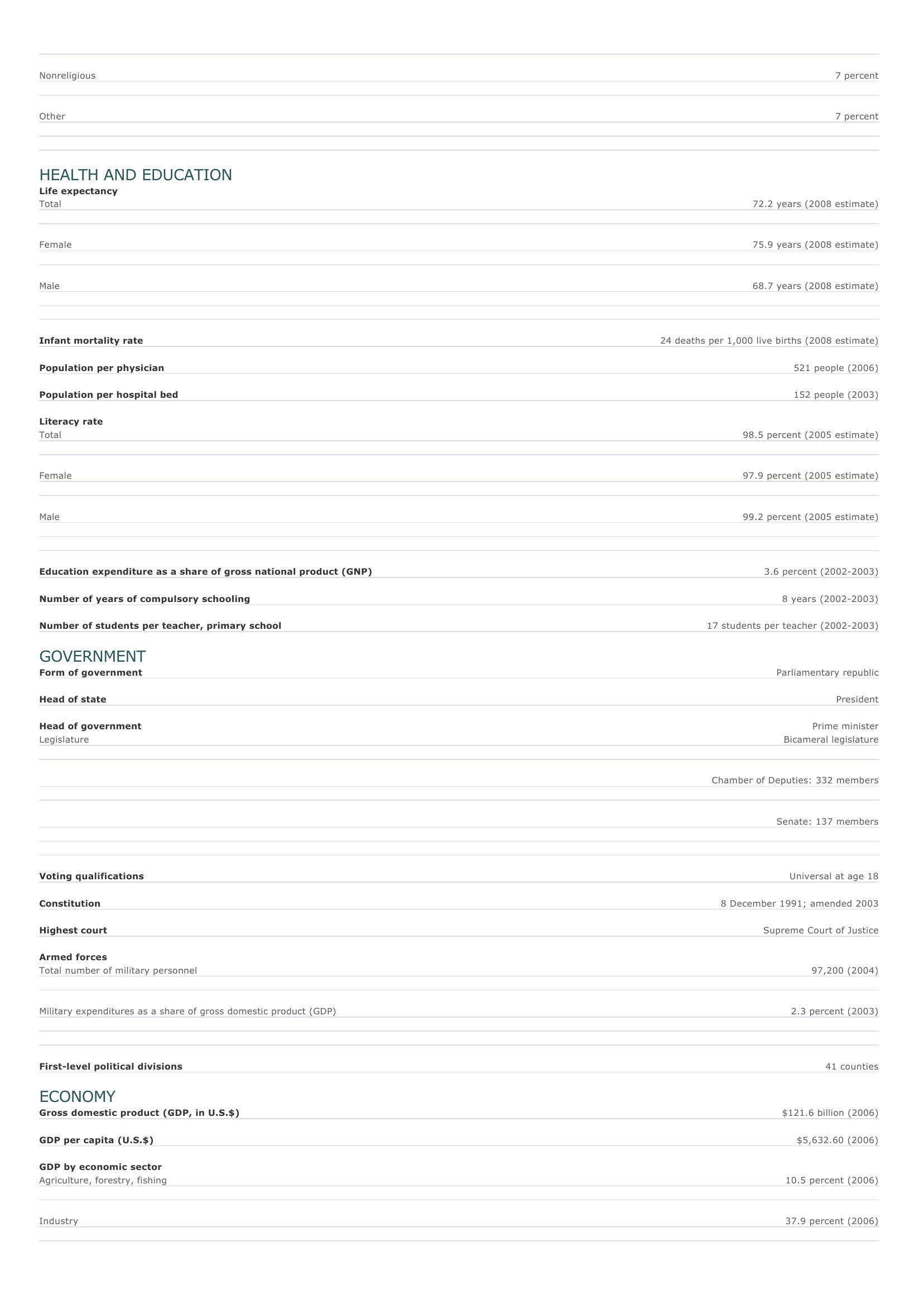Romania Facts and Figures. BASIC FACTS Official name Capital Area Romania Bucharest 238,391 sq km 92,043 sq mi PEOPLE Population 22,246,862 (2008 estimate) Population growth Population growth rate -0.14 percent (2008 estimate) Projected population in 2025 21,260,138 (2025 estimate) Projected population in 2050 18,678,226 (2050 estimate) Population density 97 persons per sq km (2008 estimate) 250 persons per sq mi (2008 estimate) Urban/rural distribution Share urban 55 percent (2005 estimate) Share rural 45 percent (2005 estimate) Largest cities, with population Bucharest 1,853,000 (2003 estimate) I a ?i 320,888 (2002) Cluj-Napoca 317,953 (2002) Timi? oara 317,660 (2002) C onstan?a 310,471 (2002) Ethnic groups Romanian 89 percent Hungarian 7 percent Roma (Gypsy) 2 percent German, Ukrainian, Serb, Croatian, Russian, Turk 2 percent Languages Romanian (official), Hungarian, German, Romani Religious affiliations Orthodox (Romanian) Christian 70 percent Roman Catholic 6 percent Protestant 6 percent Atheist 3 percent Muslim 1 percent Nonreligious 7 percent O ther 7 percent HEALTH AND EDUCATION Life expectancy Total 72.2 years (2008 estimate) Female 75.9 years (2008 estimate) Male 68.7 years (2008 estimate) Infant mortality rate 24 deaths per 1,000 live births (2008 estimate) Population per physician 521 people (2006) Population per hospital bed 152 people (2003) Literacy rate Total 98.5 percent (2005 estimate) Female 97.9 percent (2005 estimate) Male 99.2 percent (2005 estimate) Education expenditure as a share of gross national product (GNP) Number of years of compulsory schooling Number of students per teacher, primary school 3.6 percent (2002-2003) 8 years (2002-2003) 17 students per teacher (2002-2003) GOVERNMENT Form of government Head of state Head of government Legislature Parliamentary republic President Prime minister Bicameral legislature Chamber of Deputies: 332 members Senate: 137 members Voting qualifications Constitution Highest court Armed forces Total number of military personnel Military expenditures as a share of gross domestic product (GDP) First-level political divisions Universal at age 18 8 December 1991; amended 2003 Supreme Court of Justice 97,200 (2004) 2.3 percent (2003) 41 counties ECONOMY Gross domestic product (GDP, in U.S.$) GDP per capita (U.S.$) $121.6 billion (2006) $5,632.60 (2006) GDP by economic sector Agriculture, forestry, fishing 10.5 percent (2006) I ndustry 37.9 percent (2006) Services Employment Number of workers 51.5 percent (2006) 10,138,455 (2006) Workforce share of economic sector Agriculture, forestry, fishing 32 percent (2005) I ndustry 30 percent (2005) Services 38 percent (2005) Unemployment rate 8 percent (2004) National budget (U.S.$) Total revenue $11,873 million (2002) Total expenditure $11,814 million (2002) Monetary unit 1 new leu (RON), consisting of 100 bani Major trade partners for exports Italy, Germany, France, United Kingdom, and Turkey Major trade partners for imports Italy, Germany, Russia, France, and Hungary ENERGY, COMMUNICATIONS, AND TRANSPORTATION Electricity production Electricity from thermal sources 60.46 percent (2003 estimate) Electricity from hydroelectric sources 30.76 percent (2003 estimate) Electricity from nuclear sources Electricity from geothermal, solar, and wind sources Number of radios per 1,000 people 8.78 percent (2003 estimate) 0 percent (2003 estimate) 336 (1999 estimate) Number of telephones per 1,000 people 203 (2005) Number of televisions per 1,000 people 381 (2000 estimate) Number of Internet hosts per 10,000 people Daily newspaper circulation per 1,000 people Number of motor vehicles per 1,000 people Paved road as a share of total roads 23 (2003) 299 (1995 estimate) 185 (2004) 51 percent (2004) SOURCES Basic Facts and People sections Area data are from the statistical bureaus of individual countries. Population, population growth rate, and population projections are from the United States Census Bureau, International Programs Center, International Data Base (IDB) (www.census.gov). Urban and rural population data are from the Food and Agriculture Organization (FAO) of the United Nations (UN), FAOSTAT database (www.fao.org). Largest cities population data and political divisions data are from the statistical bureaus of individual countries. Ethnic divisions and religion data are largely from the latest Central Intelligence Agency (CIA) World Factbook and from various country censuses and reports. Language data are largely from the Ethnologue, Languages of the World, Summer Institute of Linguistics International (www.sil.org). Health and Education section Life expectancy and infant mortality data are from the United States Census Bureau, International Programs Center, International database (IDB) (www.census.gov). Population per physician and population per hospital bed data are from the World Health Organization (WHO) (www.who.int). Education data are from the United Nations Educational, Scientific and Cultural Organization (UNESCO) database (www.unesco.org). Government section Government, independence, legislature, constitution, highest court, and voting qualifications data are largely from various government Web sites, the latest Europa World Yearbook, and the latest Central Intelligence Agency (CIA) World Factbook. The armed forces data is from Military Balance. Economy section Gross domestic product (GDP), GDP per capita, GDP by economic sectors, employment, and national budget data are from the World Bank database (www.worldbank.org). Monetary unit, agriculture, mining, manufacturing, exports, imports, and major trade partner information is from the statistical bureaus of individual countries, latest Europa World Yearbook, and various United Nations and International Monetary Fund (IMF) publications. Energy, Communication, and Transportation section Electricity information is from the Energy Information Administration (EIA) database (www.eia.doe.gov). Radio, telephone, television, and newspaper information is from the United Nations Educational, Scientific and Cultural Organization (UNESCO) database (www.unesco.org). Internet hosts, motor vehicles, and road data are from the World Bank database (www.worldbank.org). Note Figures may not total 100 percent due to rounding. Microsoft ® Encarta ® 2009. © 1993-2008 Microsoft Corporation. All rights reserved.



